An interview with Dr Michael Kerkloh, President & CEO, Munich Airport and ACI EUROPE President. By Ross Falconer
As Bavaria’s gateway to the world, Munich Airport has an enormous impact on its region and beyond. Munich and Bavaria offer a wide catchment area, premium industries and a top consumer market.
The region is famous for its economic strength – Bavaria’s GDP of €465.5 billion exceeds that of 19 EU Member States – and is home to important high-tech, IT, and automotive industries. Consequently, Germany’s Southern region handles 40% of the country’s total cargo volume. Global players, including Siemens, BMW, Audi, Porsche, Daimler, and Bosch, have their headquarters and production plants in Southern Germany. With a large and constantly growing flight network, Munich is the gateway for these global players.
Munich Airport factbox
- 2016: 42.3 million passengers
- 2016 passenger traffic growth: 3%
- 2017 passenger traffic growth (1H): 6%
- Key airline customers: Lufthansa Group, Condor, Emirates, easyJet
- Number of routes: 248
- Top 5 domestic destinations: Berlin, Düsseldorf, Hamburg, Frankfurt, Cologne/Bonn
- Top 3 international destinations: London, Amsterdam, Paris
Furthermore, Bavaria is Germany’s number one holiday region with a strong tourism industry.
In this context, it is worth highlighting the airport’s continued traffic growth. Over the first six months of 2017, Munich Airport posted the best half-yearly figures in its history, handling 21 million passengers. “That number matches the full-year figure for 1999, and convincingly demonstrates the powerful growth dynamic achieved by Bavaria’s international hub,” says Dr Michael Kerkloh, President & CEO, Munich Airport and ACI EUROPE President. “With the substantial traffic increases, Munich Airport outpaced the industry as a whole in Germany – largely on the strength of a strong performance by the European traffic segment, which showed an impressive 8% year-on-year increase in total passengers. Meanwhile, passenger traffic in the intercontinental segment and on domestic routes was up by 6% and 4% respectively.”
That growth is forecast to continue, with 44 million passengers expected for 2017 as a whole (+4%).
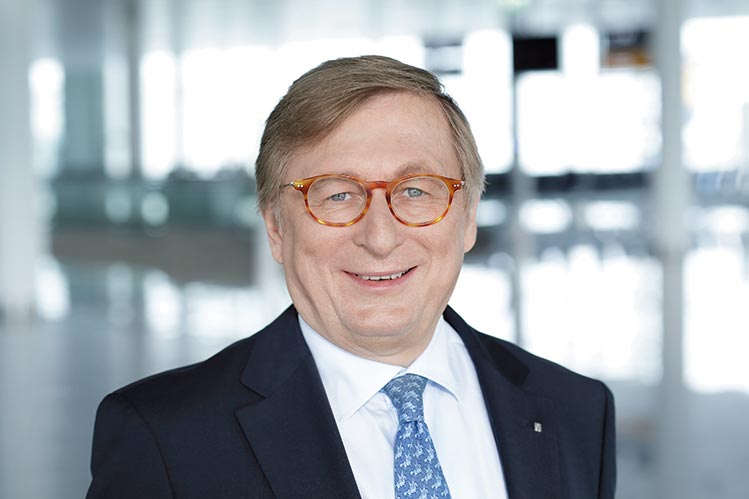
Dr Michael Kerkloh, President & CEO, Munich Airport and ACI EUROPE President: “Our future goal is to guarantee that our dynamic traffic increase will not influence passenger comfort, nor a seamless travel experience at Munich Airport – even at the point when our passenger volume will top the 50 million mark. Increasing quantity and guaranteeing quality will be our mission for the coming years.” Copyright: Flughafen München
Strategic partnership with Lufthansa
The future outlook will benefit in particular from three key strategic moves by the Lufthansa Group.
Firstly, it was announced in June that Lufthansa will base five of its 14 A380s at its Munich hub next summer, in an important development for the airport’s future competitiveness. Bavaria’s hub will join London, Paris and Frankfurt to become the fourth European airport to be home to an A380 fleet. The aircraft will be used on routes to Hong Kong, Beijing and Los Angeles. “With the foreseeable increases in intercontinental traffic, we will then be equally well positioned as a hub across all traffic segments,” Kerkloh comments.
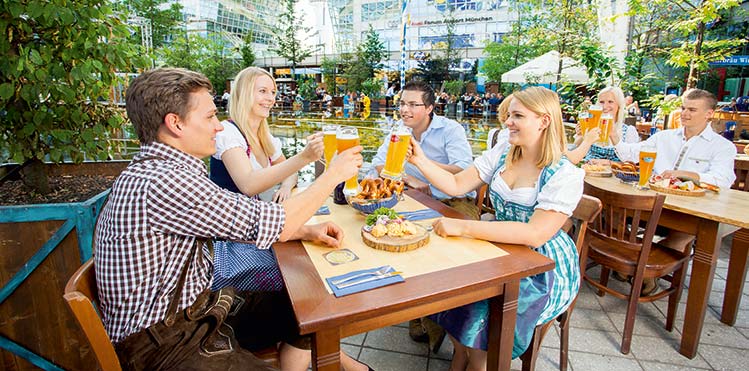
Central to the Munich Airport passenger experience is the desire to create a unique “local spirit” and true impression of the Bavarian lifestyle and hospitality. Airbräu – the world’s only airport brewery – is a prime example. Copyright: Flughafen München
Secondly, Lufthansa will base the first 15 of its 25 new A350s in Munich. “This will yield economic benefits and is also a boon to the environment,” says Kerkloh. “These advanced, highly economical and very quiet planes open up outstanding prospects for Munich Airport in the intercontinental segment. The A350 is currently the world’s most advanced and most environmentally-friendly long-haul aircraft. It uses 25% less kerosene, produces 25% fewer emissions, and is significantly quieter on take-off than comparable aircraft types.”
Thirdly, Eurowings – part of Lufthansa Group – has stationed four aircraft at Munich since the start of the summer timetable, serving 30 destinations in Europe.
These moves are a continuation of the important strategic partnership between the airport and Lufthansa. When Terminal 2 opened in 2003, it was the first time in Europe that an airport authority and an airline company had taken joint corporate responsibility for the planning, financing, construction and operation of a terminal building. The idea behind this joint venture on a 60/40 basis was to build an efficient hub system and to bundle airport and airline expertise to create a terminal offering maximum service and comfort to passengers.
Building on that, the new Terminal 2 satellite building was opened in April 2016, increasing the airport’s total capacity to 50 million.
“Our partnership with Lufthansa is crucial for the development of Munich Airport,” Kerkloh explains. “In the Hub Operations Center, 300 Lufthansa and Munich Airport employees jointly coordinate all relevant flight operations for seamless connectivity of Lufthansa flights.”
The hub operation has seen traffic numbers surge, with 15 million transit passengers per year. Indeed, the share of transit passengers has increased enormously since the opening of the new airport – from 7% in 1992 to 36% in 2016. “So, this partnership is a clear win-win-situation for all: Lufthansa, Munich Airport and the passengers,” Kerkloh adds.
The third runway
Munich’s most important development project is, undoubtedly, the third runway, which has been officially approved and has overcome all court challenges. It is now awaiting approval by the airport’s shareholders.
“Munich Airport will be able to maintain and build on its strong position in global aviation, and its important role for the region, only if it can grow with the requirements of its customers,” says Kerkloh. “The airport is already stretched to the limit with regard to available traffic slots. Since the airport opened in 1992, passenger volume has more than tripled to over 42 million. In the last five years alone, traffic has increased by almost 20%.”
This trend looks set to continue. For Germany, the Federal Ministry of Transport expects air traffic to grow by about 60% by 2030, compared to 2010 levels. This will have a significant effect on the Munich hub, with its high share of transfer passengers. “Construction of the third runway is, therefore, essential for keeping Munich and Bavaria on track for long-term growth, and for continuing their success. Munich Airport’s runway capacity is currently at its limit during eight to ten operating hours per day. Airline requests for additional slots and the corresponding flight connections have to be turned down. Due to the current growth trend, the bottlenecks will only get worse.”
The third runway has strong support from the business sector. So far, 228 companies and associations have publicly backed the project – and the list is steadily growing. “That is the biggest business alliance ever assembled in support of an infrastructure project in Germany, and is also outstanding in the European context. We will certainly continue bringing this crucial future project forward,” Kerkloh adds.
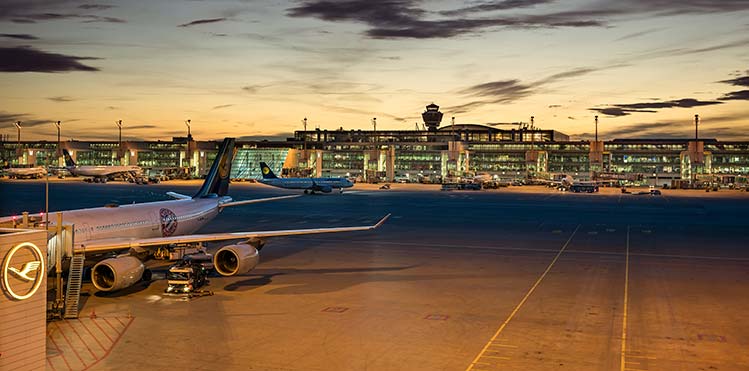
The future outlook for MUC will benefit from three key strategic moves by the Lufthansa Group: Lufthansa will base five of its 14 A380s at its Munich hub next summer, the airline will also base the first 15 of its 25 new A350s in Munich, and Eurowings has stationed four aircraft at Munich since the start of the summer timetable. Copyright: Flughafen München
‘Balance of power’ in route network
While constrained in terms of available slots, the airport does have a proactive route development strategy focused on hub traffic, point-to-point, low-cost and cargo traffic. Significantly, in June, Condor expanded its long-haul network from Munich with a twice-weekly service to Seattle, while Ryanair will begin twice-daily Dublin-Munich operations in October.
“I would say that the ‘balance of power’ is important to us,” says Kerkloh. “Our main target is to become part of the European ‘Champions League’ – therefore, we intend to further increase our long-haul network. Bogota, Dallas, Ho Chi Minh City, Manila, Nairobi and Sao Paolo are some of the destinations we are targeting. Currently, we have airlines waiting for traffic rights to operate new routes, for example, from Munich to Addis Abeba and Taipei.”
The airport also gives marketing support for all segments in the form of market expertise, and the transfer of know-how and manpower to carry out joint sales, marketing and PR activities.
Eco-Innovation Award
Environmental innovation is also at the heart of Munich’s corporate strategy. Its target is to achieve carbon neutral operations by 2030, and the airport is already accredited at Level 3 Optimisation of ACI’s Airport Carbon Accreditation. These efforts were recognised at this year’s ACI EUROPE Best Airport Awards, where Munich won the Eco-Innovation Award, the judges praising “its comprehensive and systematic approach to environmental management and sustainability across all its operations and in relation to all its impacts”.
“Our ambitious target is to reduce the CO2 emissions directly attributable to the airport’s operations by 60%. The remaining 40% will take the form of carbon offsets,” Kerkloh explains.
The package of measures for achieving carbon neutrality covers myriad areas, notably the energy supply, efficiency improvements in building systems, vehicle fleet optimisation, exterior lighting, and further improvements in electric power use by the baggage transport system. Improvements already being implemented include climate-optimised façades, a switch to LED runway lighting, and greater use of electro-mobility in the airport’s vehicle fleet.
“For us, climate protection is an important strategic target,” says Kerkloh. “We’re not just talking about it. We’re taking action and implementing innovative measures to effectively reduce emissions at the airport. The costs of this climate protection programme between now and 2030 will total €150 million.”
Munich takes a collaborative approach to environmental sustainability, for instance within the framework of the Aviation Initiative for Renewable Energy Germany (aireg e.V.), through which industry stakeholders are working together to promote and expand the use of biofuel. Munich Airport is among the founding members of the initiative.
“aireg e.V. is looking to replace 10% of the German jet fuel demand with sustainable, alternative aviation fuels by 2025. Munich is the only German airport promoting this extraordinary initiative,” Kerkloh comments. “Bringing together different partners to achieve common goals is the key to success. Another example of cooperation between the airport and its stakeholders is Airport Collaborative Decision Making, or A-CDM, which is important to further optimise key operational processes at our airport. A-CDM provides the basis for the link between the airport and the national and international air traffic management network. Such smart processes help to further reduce CO2 emissions.”
‘InnovationPilot’: crowd-sourced innovation
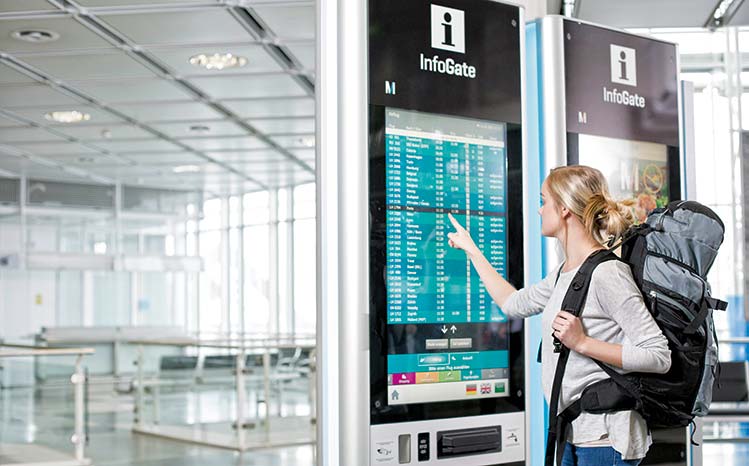
Munich Airport has a comprehensive digital strategy. One of the digital channels it uses to communicate with passengers is InfoGate – a multifunctional information and wayfinding tool. Copyright: Flughafen München
This innovative approach to sustainability is mirrored by the airport’s progressive vision for the passenger experience.
Earlier this year, Munich Airport launched a new ‘digital welcome mat’ via its relaunched website – just one example of a comprehensive digital strategy that includes free unlimited WiFi and a strong social media presence on Facebook (140,000 ‘fans’), Twitter (20,000 followers) and Instagram (30,000 followers).
“Digital channels and social media interactions help us get to know our end customers,” says Kerkloh. “It’s all about being there for them along the entire customer journey. In everything we do, our starting point is the end customer’s needs. Other digital channels we use to talk to our end customers are the Passngr App and InfoGate. Our WLAN will also become a decisive channel for customer communication in the future. These are all channels that we plan to use even more to provide end customers with exactly the information that is relevant and interesting to them.”
Central to the passenger experience is the desire to create a unique “local spirit”, so passengers immediately recognise that they have landed in Munich. This is perhaps most vividly seen in the retail and food & beverage concepts. “We want travellers from all over the world to get a first impression of the Bavarian lifestyle and hospitality right from the time they set foot here. Airbräu – the world’s only airport brewery – is a prime example,” Kerkloh explains.
The airport is further embracing innovation through the ‘InnovationPilot’ platform, which is designed to generate ideas for the airport of the future. This new, crowd-sourced innovation platform pools the knowledge and experience of the airport’s 8,000 employees. It even draws on the input of interested passengers.
“This enables employees and customers to make active contributions to the airport’s future, from technical suggestions for faster processing operations in Terminal 1 to fresh ideas for events in the upcoming season,” Kerkloh enthuses.
Instead of simply collecting proposals to improve existing processes, the idea is to stimulate a co-creation approach to collaboratively discuss and develop new ideas. In the first year of operation, more than 1,200 ideas were submitted and discussed.
“Discussions with customers on ideas for a more relaxed and interesting passenger experience in Terminal 1 at Munich Airport wrapped up at the beginning of September,” Kerkloh shares. “The many exciting ideas range from live radar tracking of take-offs and landings, the ‘greening’ of the terminal and the expansion of the relaxation zone, to a dynamic LED guidance system.”
Tailor-made international consulting
Munich Airport is also involved in managing airports around the world, and in July it established a new 100% subsidiary for its international activities. With Munich Airport International (MAI), it now has a tailor-made platform for handling international contracts in the areas of consulting, airport management and training previously implemented by the parent company. Within the last 25 years Munich has provided tailor-made solutions at more than 50 airports, including Bangkok, Quito, Madrid, Barcelona, Rio de Janeiro, and Delhi. Apart from airports, customers include governments, airlines, construction companies and various consultancies.
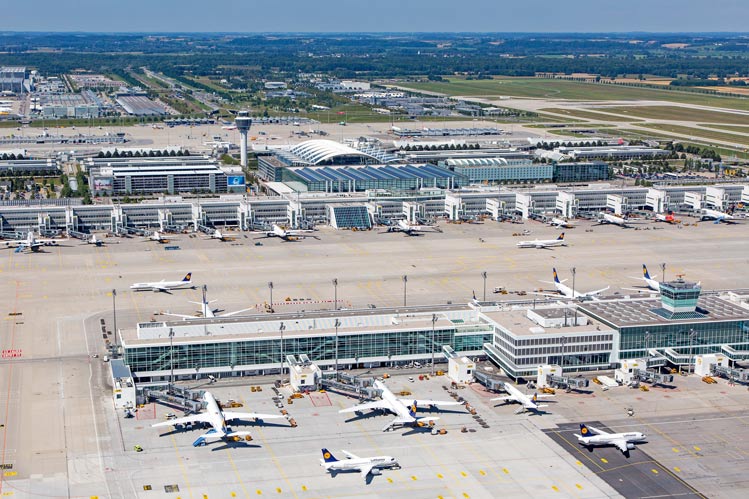
Dr Michael Kerkloh, President & CEO, Munich Airport and ACI EUROPE President: “I would say that the ‘balance of power’ is important to us. Our main target is to become part of the European ‘Champions League’ – therefore, we intend to further increase our long-haul network.” Copyright: Flughafen München
“MAI’s service portfolio covers all aspects of airport and terminal planning, the commissioning of new facilities (Operational Readiness and Airport Transfer), operational planning and process optimisation, profit and revenue optimisation, airport privatisation consulting, tailor-made training services and comprehensive airport management,” Kerkloh explains.
These developments are all taking place against the backdrop of Munich Airport’s 25th anniversary at its current location, which it officially celebrated in May with activities including an official state reception and a 20,000sqm festival area next to the airport’s visitors park that welcomed 60,000 guests.
“With the foreseeable increases in intercontinental traffic, our high-quality airport will attain a new standard of quality in the coming years. We will then be equally well positioned as a hub across all traffic segments. We’re now in the enviable position of being poised to add more chapters to our success story for the next 25 years – in the interests of Bavaria and the people who live here,” Kerkloh concludes.
Dr Michael Kerkloh elected ACI EUROPE President
In June, Dr Michael Kerkloh, President & CEO, Munich Airport, was elected President of ACI EUROPE during the association’s General Assembly, Congress & Exhibition.
“I am excited to be continuing the successful work of my predecessors, and bringing more visibility to both the issues affecting the airport industry and to the work of the ACI EUROPE team in Brussels,” he says. “I consider the following points as the most pressing challenges on the ACI EUROPE agenda: security, the EU Aviation Strategy and how airports need to continue supporting it, climate action, the capacity crunch, digitalisation and airports, and Brexit.”
Dr Kerkloh is a longstanding member of the airport industry, having worked in various roles at Frankfurt and Hamburg airports, before being appointed to the position of CEO at Munich Airport in 2002. He is a past President of the national airport association in Germany, ADV, and a member of the Executive Committee of BDL, the German Aviation Industry Association.








